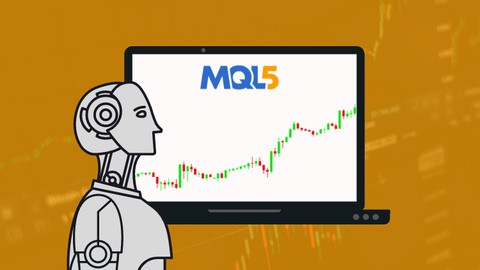Complete 2-in-1 Python for Business and Finance Bootcamp
Loại khoá học: Finance
Data Science, Statistics, Hypothesis Tests, Regression, Simulations for Business & Finance: Python Coding AND Theory A-Z
Mô tả
(Latest course update and full review in May 2023. Now with more than 30 Udemy Online Coding Exercises - NEW Feature!)
Hi and welcome to this Course!
This is the first-ever comprehensive Python Course for Business and Finance Professionals. You will learn and master Python from Zero and the full Python Data Science Stack with real Examples and Projects taken from the Business and Finance world.
This isn´t just a coding course. You will understand and master all required theoretical concepts behind the projects and the code from scratch.
Important: the quality Benchmark for the theory part is the CFA (Chartered Financial Analyst) Curriculum. The Instructor of this course holds a Master´s Degree in Finance and passed all three CFA Exams. In this course, we leave absolutely no room for wrong/dubious (but frequently promoted) practices like LSTM stock price predictions or using stock prices in linear regressions.
You will become an expert not only in Python Coding but also in
Business & Finance (Time Value of Money, Capital Budgeting, Risk, Return & Correlation, Monte Carlo Simulations, Quality and Risk Management in Production and Finance, Mortgage Loans, Annuities and Retirement Planning, Portfolio Theory, Portfolio Optimization, Asset Pricing & Factor Models, Value-at-Risk)
Statistics (descriptive & inferential statistics, Confidence Intervals, Hypothesis Testing, Normal Distribution & Student´s t-distribution, p-value, Bootstrapping Method, Monte Carlo Simulations, Normality of Returns)
Regression (Covariance & Correlation, Linear Regression, Multiple Regression and its pitfalls, Hypothesis Testing of Regression Coefficients, Logistic Regression, ANOVA, Dummy Variables, Links to Machine Learning, Fama-French Factor Models)
This course follows a mutually reinforcing concept: Learning Python and Theory simultaneously:
Learning Python is more effective when having the right context and the right examples (avoid toy examples!).
Learning and mastering essential theories and concepts in Business, Finance, Statistics and Regression is way easier and more effective with Python as you can simulate, visualize and dynamically explain the intuition behind theories, math and formulas.
This course covers in-depth all relevant and commonly used Python Data Science Packages:
Python from the very Basics (Standard Library)
Numpy and Scipy for Numeric, Scientific, Financial, Statistical Coding and Simulations
Pandas to handle, process, clean, aggregate and manipulate Tabular (Financial) Data. You deserve more than just Excel!
statsmodels to perform Regression Analysis, Hypothesis Testing and ANOVA
Matplotlib and Seaborn for scientific Data Visualization
This course isn´t just videos:
Downloadable Jupyter Notebooks with thousands of lines of code
Downloadable PDF Files containing hundreds of slides explaining and repeating the most important concepts
Downloadable Jupyter Notebook with hundreds of coding exercises incl. hints and solutions
I strictly follow one simple rule in my coding courses: No code without explaining the WHY. You won´t hear comments like "...that´s the Python code, feel free to google for more background information and figure it out yourself". Your boss, your clients, your business partners and your colleges don´t accept that. Why should you ever accept this in a course that builds your career? Even the best (coding) results have only little value if they can´t be explained and sold to others.
I am Alexander Hagmann, Finance Professional and best-selling Instructor for (Financial) Data Science, Finance with Python and Algorithmic Trading. Students who completed my courses work in the largest and most popular tech and finance companies all over the world. From my own experience and having coached thousands of professionals and companies online and in-person, there is one key finding: Professionals typically start with the wrong parts of the Python Ecosystem, in the wrong context, with the wrong tone and for the wrong career path.
Do it right the first time and save time and nerves! What are you waiting for? There is no risk for you as you have a 30 Days Money Back Guarantee.
Thanks and looking forward to seeing you in the Course!
Bạn sẽ học được gì
Learn Python coding from Zero in a Business, Finance & Data Science context (real Examples)
Learn Business & Finance (Time Value of Money, Capital Budgeting, Risk, Return & Correlation)
Learn Statistics (descriptive & inferential, Probability Distributions, Confidence Intervals, Hypothesis Testing)
Learn how to use the Bootstrapping method to perform hands-on statistical analyses and simulations
Learn Regression (Covariance & Correlation, Linear Regression, Multiple Regression, ANOVA)
Learn how to use all relevant and powerful Python Data Science Packages and Libraries
Learn how to use Numpy and Scipy for numerical, financial and scientific computing
Learn how to use Pandas to process Tabular (Financial) Data - cleaning, merging, manipulating
Learn how to use stats (scipy) for Statistics and Hypothesis Testing
Learn how to use statsmodels for Regression Analysis and ANOVA
Learn how to create meaningful Visualizations and Plots with Matplotlib and Seaborn
Learn how to create user-defined functions for Business & Finance applications
Learn how to solve and code real Projects in Business, Finance & Statistics
Learn how to unleash the full power of Python and Numpy with Monte Carlo Simulations
Understand and code Sharpe Ratio, Alpha, Beta, IRR, NPV, Yield-to-Maturity (YTM)
Learn how to code more advanced Finance concepts: Value-at-Risk, Portfolios and (Multi-) Factor Models
Understand the difference between the Normal Distribution and Student´s t-distributions: what to use when
Yêu cầu
- No (Python) Coding required. This Course starts from complete zero und teaches you everything from scratch.
- No specific Business/Finance, Statistics & Data Science knowledge needed! The course intuitively explains basic and advanced concepts.
- A desktop computer (Windows, Mac, or Linux) capable of storing and running Anaconda. The course will walk you through installing the necessary free software.
- An internet connection capable of streaming videos.
- Some high school level math skills would be great (not mandatory, but it helps)
Nội dung khoá học
Viết Bình Luận
Khoá học liên quan

Đăng ký get khoá học Udemy - Unica - Gitiho giá chỉ 50k!
Get khoá học giá rẻ ngay trước khi bị fix.


















Đánh giá của học viên
Bình luận khách hàng